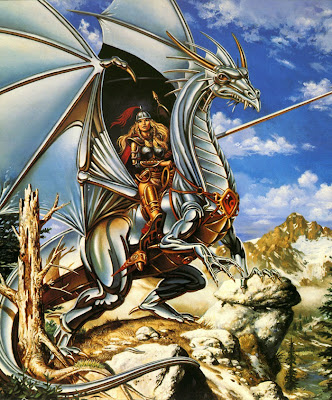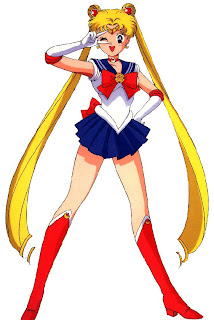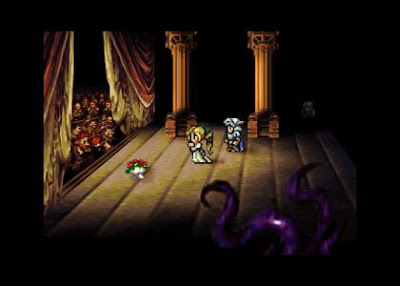This week on Gamasutra, Emily Short wrote a fantastic short article about the Heroine’s Journey. I admire Emily and I think her analysis is bang-on, but it seems like there was some controversy in the comments about whether or not such a thing even exists.
This is a topic near and dear to me. As a child, I was always looking for awesome heroines to look up to. I own a hand-carved badge that says “Heroine Addict.” I also have done a lot of reading about “The Hero’s Journey,” because I often had to teach it in my game design classes. So I’ve read the original, dense Campbell works, interviews with him about it, and all of that good stuff.
I won’t bother to explain the Hero’s Journey now because it seems like it’s something that’s been explained better elsewhere, or that most people understand. I explain it “for dummies” in a lot of video game design classes. If you’re a person who wonders why it’s so common for video games to tell just this story, I have a few theories. One is that the Hero’s Journey is the first type of epic story structure that a student is introduced to in a “Storytelling 101” classroom atmosphere. How to intelligently break the formula would be “Storytelling 102,” but if someone is after a specialized video game design degree, there is no Storytelling 102 class. He or she has got to get out of there, so he/she can learn programming or ZBrush or the stuff that will actually land job interviews. I’m not saying that the people who are higher up in game studios don’t know how to do different types of stories, just that this story is going to be at the forefront of people’s minds. Another reason, I feel, it’s used so often is that, for the audience, it really works.
So, given: some say the Hero’s Journey is a necessary formula for epic storytelling. Others believe it’s overused and overdone. But the Hero’s Journey is called the Hero’s Journey even if the protagonist of this story is a woman. Usually the protagonist of a Hero story is male, but there are a few exceptions. In video games, these usually take the form of a story that stars a woman on accident, because the protagonist of the story was default a man, but allowed a woman to be selected by the player. Games like this are legion; examples include Mass Effect, Fallout 3, and Fable II and III. All of these are Hero’s Journey type stories written for male protagonists that allow the player to choose a female anyway.
Maybe this is why some men don’t seem to agree that a story actually written for a female tends to be different. Emily gives some great classical examples in her article: Cinderella, Snow White, Jane Eyre. I’ll try out some more modern examples from my own childhood experiences.
Serena/Usagi is a clumsy girl in school who is often teased. One day, a mysterious talking cat shows up with a magical broach. It turns out that, in her past life, she was The Princess of the Moon Kingdom. She has been reincarnated on Earth, and her past life gives her powers that allow her to do amazing deeds. With the new gift given to her, she can transform into the Pretty Solider Sailor Moon, and save people from evil forces! At the end of the first part of her story, her friends sacrifice themselves so she can survive, and then she also dies in a blaze of glory. Later, she has magic future babies.
Terra Branford is also a very mysterious young woman. She begins her story trapped by the forces of evil. She has some kind of special power, but needs to be rescued before she can understand it. As it turns out, she is special: a natural sorceress born from the union of a human mother and an enchanted creature called an Esper. Her special powers make her the one who must save the world from evil forces. At the end of her story, she becomes surrogate mother to an orphanage.
Samus Aran. Poor Samus. She could have had a Hero’s Journey, but it was quickly revised. Her story starts when her entire family was slaughtered by a space pirate attack. She is adopted by the Chozo, a kind and wise race, and given a transfusion of their blood to save her life. The blood gives her special powers. To utilize this, she is given a power suit, which is an organic part of her body and allows her to do amazing feats. She must realize her destiny: to save the galaxy from evil forces. At the end of her story, she becomes surrogate mother to an alien creature, which she protects with her life.
These are all stories of Japanese origin, but remember that the Hero’s Journey is global. Along with the classical fairy tales starring women, both Disney and non-Disney versions, these are a few of the heroine stories I had growing up, which is why I’m mentioning them now.
In the Hero’s Journey, the Hero often receives some kind of Boon: a powerful gift that allows him to defeat evil and save the day. Note that in a Heroine’s Journey, this is the actual beginning of her story, rather than something that happens near the “second act.” Samus is given her suit as a child. Serena is given her transformation ability… and then the real story starts. Terra’s boon is also a gift she was born with as a child. (She has to learn to master it, but her story is closer to a hero’s story than the other two, which I’ll try to elaborate on.)
Let’s take a look at another part of the monomyth: Crossing the Threshold. This is where the story for a hero begins. The heroine, if she has a Boon, is going to get it now, and not later. Alice and Dorothy are classical heronies who come to mind as fitting this pattern of crossing in to a world of adventure. Alice is rare in that she gets no trinket, but when does Dorothy get her magical shoes? Right at the start.
I believe the reason a woman is given a magical item or talent very early is because even the most heroic story believes it would be unkind to see her struggle. Poor Cinderella, working so hard to dutifully provide for her cruel family. Her story really starts when the Fairy Godmother appears to rescue her. The Boon by its nature is something given, it comes from the outside, and is often combined with a rescue that saves the heroine from a dire fate. I believe this to be different from the simple “supernatural aid” item given to a male hero at the beginning of a story, because the woman usually gets the real ultimate power right up front.
The woman, in other words, is given a thing, for being intrinsically special or having some special virtue. She does not take the thing for herself. This would be considered a villainous act.
Women’s sacrifice also should be in the service of others whom she directly knows. It wouldn’t be feminine for Samus Aran to want to use the power suit to get more money hunting bounties, or even merely to save the entire galaxy. She must have a thing like a child to protect. Themes of motherhood, and sacrifice for motherhood are common in heroine’s journeys. If they are not in the story, then the woman sacrifices for her family in general, or her friends. A hero can sacrifice himself to save “the world,” but this isn’t personal or intimate enough for a heroine.
In addition to sacrifice for children and family, another very important component of these stories is beauty and grace. Classical heroines are prized for their beauty. Snow White was the fairest in the land. The Little Mermaid was notable for having a lovely voice. As for the heroines in video games, well, you’ll never find one that isn’t attractive. To paraphrase Peggy Orenstein, you can save the kingdom, or even the galaxy, as long as you look hot doing it. Looking beautiful is a very important part of being a heroine.
As a result, the heroine’s struggle is minimized slightly, so that she doesn’t get any dirt on her face in the process of being the heroine. Sure, Luke was given his light saber early, but it’s just a sword. He had to train to use it. A training montage for a woman, where she gets cuts on her face, has to run miles, or get in to training swordfights, now that’s just absurd. She might sweat, or develop unsightly bruises and injuries! Now that I’ve said that, I know there are some examples of this very thing, but it’s far from the norm. Do you love that training montage from Mulan? Lord, I do. Remember, she’s acting a boy’s part here. What’s the real female equivalent? Makeover!!
The rules change slightly when the heroine is a woman pretending to be a man. In those cases, such as the film Mulan, the heroine does have access to the tropes commonly only allowed for male characters. This is a Hero’s Journey with a gender reversal, not a Heroine’s Journey exactly. It can also go the other way. In my comment on Gamasutra I mentioned that I think Harry Potter starts out as a “Heroine’s Journey.” This is because Harry follows the beginning arc usually followed by a female, in fairy tales: he is abused, mistreated, and made to serve others. Then he is called “the Chosen One” and whisked away. He gets by early in the story on innate talents rather than struggle, which is also more of a Heroine story than a Hero story. However, it’s definitely mixed, as Harry’s story is more traditionally masculine in how it handles his relationship with authority figures, his father, and his friends. It also doesn’t really matter so much what he looks like. Everyone comments on his scar, but it’s hard to imagine a young heroine could get away with facial scarring.
I promised I’d revisit Terra a little. Final Fantasy VI in many respects tells a traditional Hero’s Journey starring a woman. Terra does start the story with super powers, but she has to learn to use them, and she undergoes a personal transformation when she does, changing her in to another type of being. She is spiritually reborn, a common aspect of these stories, and she is also Master of Two Worlds being half human, half Other.
The second half of the game isn’t about her. It switches viewpoints to another character. The most common read of Final Fantasy VI is that it’s an “ensemble cast,” since it view switches periodically. (I would rather say it’s a game which happens to co-star two women, and a lot of other great people, with Terra’s story beginning as primary.) The second main-character in the story is Celes. When I was a child she was my personal favorite between the two, but her story is much more classically female. She starts out as a cold, heartless young woman, but is softened by love and friendship. She is also given a makeover. And sings.
And I have nothing against any of that. In fact, being beautiful, graceful, talented, and self-sacrificing… in addition to being smart, clever, strong, quick, and sure, are all wonderful parts of a heroine fantasy that can touch the heart and imagination.
It’s a lot to live up to, though. The male fantasy is allowed to be personal. It is often more about a man confronting his father and becoming his own person. The female story is about getting ready to make the world for her children. There is very little room for “Hero” among Madonna/Whore, among Maiden/Mother/Crone.




Leave a Reply